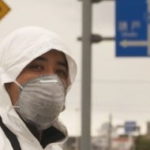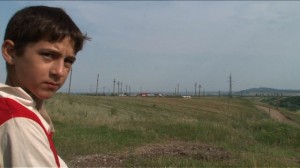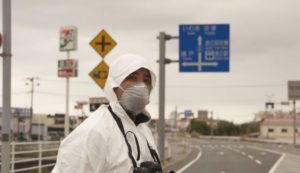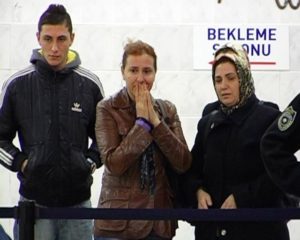•••• Retour programme 2012 / Back festival line-up here ••••
Samedi/Saturday 10 nov • dimanche/Sunday 11 nov • Lundi/Monday 12 nov • Mardi/Tuesday 13 nov • Mercredi/Wednesday 14 nov • Jeudi/Thursday 15 nov • Vendredi/Friday 16 nov •
• De 14h00 à 17h00 •
 Adak
Adak
Offering
Turquie | 2011 | 23 min | vostf
un film de / directed by : Amandine Faynot (France)
 Je me demande si on n’aurait pas mieux fait de rester seuls
Je me demande si on n’aurait pas mieux fait de rester seuls
Sometimes Wonder If We Wouldn’t Have Been Better Off Alone
Roumanie | 2011 | 86 min | vostf
un film de / directed by : Jonathan Larcher (France)
• De 17h30 à 19h30 •
 Métal Marioupol
Métal Marioupol
Metal Marioupol
Ukraine | 2012 | 94 min | vostf
un film de / directed by : Blandine Huk, Frédéric Cousseau (France)
• De 20h30 à 23h00 •
 Fukushima: Memories of the Lost Landscape
Fukushima: Memories of the Lost Landscape
Fukushima, mémoires d’un paysage perdu
2011 | Japon | 109 min | vosta
un film de / directed by : MATSUBAYASHI Yojyu (Japon)
Adak
Offering
Turquie | 2011 | 23 min | vostf
un film de / directed by : Amandine Faynot (France)
image / photography : Amandine Faynot, Sarisakal Volkan
montage / editing : Amandine Faynot
son / sound : Amandine Faynot, Jean Baptiste Madry
production/distribution : Amandine Faynot (Paris, France) – amandine.faynot(at)gmail.com
EN PRÉSENCE DE LA RÉALISATRICE / FOLLOWED BY A DISCUSSION WITH THE FILMMAKER
À Istanbul, le sacrifice du mouton, rituel encore récemment orchestré par le père de famille, est désormais accueilli dans une enceinte publique municipale. Une loi nouvellement adoptée interdit aux particuliers d’accomplir ce sacrifice dans les espaces publics ou privés. Des sacrificateurs professionnels y mettent en scène une mise à mort en série, codifiée, parfaitement réalisée. La mutation des codes régissant ces rites questionne. La catharsis provoquée par le sacrifice existe-elle encore lorsque la violence est institutionnalisée ?
In Istanbul, the sacrifice of the sheep used to be performed by the head of the household, is now practiced in a municipal public place. A recently adopted law prohibits individuals from carrying out this sacrifice in a non-specified public or private place. As professional sacrificers now stage a codified, perfectly realized, mass killing, the mutation of the codes governing these rituals raises personal questions. Does the catharsis provoked by sacrifice still exist when the violence is institutionalized ?
__________
Diplômée de l’ENSAD Paris (Ecole nationale supérieure des Arts Décoratifs) en photo-vidéo, Amandine Faynot a participé au programme Erasmus de l’Université de cinéma de Marmara (Istanbul). Son mémoire de master, sous la direction de Clarisse Hahn, était consacré au thème “Comment filmer la violence dans le cinéma documentaire”.
__________
haut de page / top of the page
 Je me demande si on n’aurait pas mieux fait de rester seuls I Sometimes Wonder If We Wouldn’t Have Been Better Off Alone
Je me demande si on n’aurait pas mieux fait de rester seuls I Sometimes Wonder If We Wouldn’t Have Been Better Off Alone
Roumanie 2011 | 86 min | vostf
un film de / directed by : Jonathan Larcher (France)
image, son et montage / photography, sound and editing :
Jonathan Larcher
production/distribution : Jonathan Larcher (Paris, France) – larcherj(at)hotmail.fr
EN PRÉSENCE DU RÉALISATEUR / FOLLOWED BY A DISCUSSION WITH THE FILMMAKER
L’histoire d’une rencontre entre un curieux et des hommes et des femmes que sa curiosité n’intéresse pas. Pour ces tsiganes roumains comme pour l’ethnologue étranger, l’hospitalité s’offre et se reçoit avec défiance. “J’ai cru un temps que je ne pourrais pas raconter d’histoire avant de comprendre qu’elle était déjà commencée ; engagée par nos négociations, leurs menaces et nos échanges monétaires.” (J.L.)
The story of an encounter between an inquisitive fellow and men and women who don’t take any interest in his nosiness. For these Romanian Gypsies as much as for the foreign ethnologist, hospitality is something offered and received with mistrust. “At some point, I thought I would be unable to tell any story at all before I realized it had already begun, started up by our negotiations, their threats and our monetary exchanges.” (J.L.)
site officiel / official website : https://vimeo.com/jonathanlarcher
__________
Doctorant en ethnologie à l’EHESS (Paris), Jonathan Larcher mène des recherches sur l’identité d’un groupe tsigane en Roumanie. Ses réalisations documentaires s’appuient sur l’étude monographique d’un village de la plaine de Bucarest où il a réalisé, en 2009, Viaţa la noi (La vie chez nous), film d’étude qui a reçu le prix d’anthropologie visuelle EHESS-CNRS Image. Je me demande si on n’aurait pas mieux fait de rester seuls est son premier long métrage documentaire.
__________
haut de page / top of the page
 Métal Marioupol
Métal Marioupol
Metal Marioupol
Ukraine | 2012 | 94 min | vostf
un film de / directed by : Blandine Huk, Frédéric Cousseau (France)
image / photography : Frédéric Cousseaumontage / editing : Blandine Huk, Frédéric Cousseau
son / sound : Blandine Huk
production/distribution : Nofilm (Paris, France) – nofilm(at)free.fr
EN PRÉSENCE DES CINÉASTES / FOLLOWED BY A DISCUSSION WITH THE FILMMAKERS
Une petite ville de 500 000 habitants sur les bords de la mer d’Azov. Une petite ville dont le nom grec de Marioupol sonne comme celui d’une station balnéaire. Une petite ville d’Ukraine qui vit au rythme de ses aciéries et du souvenir d’une histoire brutale et mouvementée au XXe siècle.
A small city of 500,000 inhabitants on the shores of the Sea of Azov. A small town whose name Marioupol is of Greek origin and sounds like a seaside resort. A small town in Ukraine, living to the rhythm of its steel mills.
site officiel / official website : http://nofilm.free.fr/marioupolfrenchtrailer.html
__________
Blandine Huk est née en 1969 à Mulhouse. Journaliste, elle débute dans le documentaire comme assistante réalisatrice sur le film Sakhaline (2006).
Filmographie : Un dimanche à Pripiat (2006) ; Rouge Nowa Huta (2009) ; Garboucha (2009) ; Le goût du cochon (2010)
Frédéric Cousseau est né en 1963 à Paris. Tout d’abord musicien rock/punk, il commence à réaliser des films (fiction, documentaire, expérimental) à la fin des années 80.
Filmographie : Des pieds et des mains (1989) ; Bartolin (1991) ; La fatigue (1998) ; Le 17 au soir (2005) ; Sakhaline (2006) ; Un dimanche à Pripiat (2006) ; Rouge Nowa Huta (2009) ; Garboucha (2009) ; Le Goût du cochon (2010) ; Body (2010) ; Pornographic Isolation (2011)
__________
haut de page / top of the page
 Fukushima: Memories of the Lost Landscape Fukushima, mémoires d’un paysage perdu 2011
Fukushima: Memories of the Lost Landscape Fukushima, mémoires d’un paysage perdu 2011
Japon | 109 min | vosta
un film de / directed by : MATSUBAYASHI Yojyu (Japon)
image, son et montage / photography, sound and editing :
MATSUBAYASHI Yojyu
production : 3 JoMa Films (Tokyo, Japon) – yojyu220(at)gmail.com
distribution : Tofoo, LLC. (Tokyo, Japon) – info(at)tongpoo-films.jp
